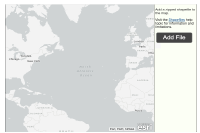 Hide Table of Contents
Hide Table of Contents
 Analysis
Analysis
 Dynamic Layers
Dynamic Layers
 Editing
Editing
 Feature Layers
Feature Layers
 Feature Table
Feature Table
 Graphics
Graphics
 Map
Map
 Mobile
Mobile
 Online and Portal
Online and Portal
 Popups and Info Windows
Popups and Info Windows
 Query and Select
Query and Select
 Renderers, Symbols, Visualization
Renderers, Symbols, Visualization
 Search
Search

Explore in the sandbox
View live sample
Description
The ArcGIS Portal API is a REST API that allows developers to work with content from ArcGIS Online. Portions of this API were integrated into the ArcGIS API for JavaScript at version 2.8. If you need access to capability not exposed via the classes in the ArcGIS API for JavaScript you can use esri/request to work directly with the ArcGIS Portal REST API.
This sample demonstrates how to use theGenerateoperation to generate a feature collection from an input shapefile. The application contains a form with an input element of type file that allows users to navigate to a zipped shapefile. This snippet calls the generate operation, note that the form used to capture the input shapefile is specified using the form parameter.
When the generate operation successfully completes the addShapefileToMap function is executed that adds the feature collection to the map.
Note: There are some limitations to be aware of when adding shapefiles to the map. View theAbout shapefileshelp topic in ArcGIS.com documentation for details.
Code
<!DOCTYPE HTML>
<html>
<head>
<meta http-equiv="Content-Type" content="text/html; charset=utf-8">
<meta name="viewport" content="initial-scale=1, maximum-scale=1,user-scalable=no">
<title>Add Shapefile</title>
<link rel="stylesheet" href="https://js.arcgis.com/3.46/dijit/themes/claro/claro.css">
<link rel="stylesheet" href="css/app.css">
<link rel="stylesheet" href="css/fileupload.css">
<link rel="stylesheet" href="https://js.arcgis.com/3.46/esri/css/esri.css">
<script src="https://js.arcgis.com/3.46/"></script>
<script>
var map;
require([
"esri/config",
"esri/InfoTemplate",
"esri/map",
"esri/request",
"esri/geometry/scaleUtils",
"esri/layers/FeatureLayer",
"esri/renderers/SimpleRenderer",
"esri/symbols/PictureMarkerSymbol",
"esri/symbols/SimpleFillSymbol",
"esri/symbols/SimpleLineSymbol",
"dojo/dom",
"dojo/json",
"dojo/on",
"dojo/parser",
"dojo/sniff",
"dojo/_base/array",
"esri/Color",
"dojo/_base/lang",
"dijit/layout/BorderContainer",
"dijit/layout/ContentPane",
"dojo/domReady!"
],
function (
esriConfig, InfoTemplate, Map, request, scaleUtils, FeatureLayer,
SimpleRenderer, PictureMarkerSymbol, SimpleFillSymbol, SimpleLineSymbol,
dom, JSON, on, parser, sniff, arrayUtils, Color, lang
) {
parser.parse();
var portalUrl = "https://www.arcgis.com";
on(dom.byId("uploadForm"), "change", function (event) {
var fileName = event.target.value.toLowerCase();
if (sniff("ie")) { //filename is full path in IE so extract the file name
var arr = fileName.split("\\");
fileName = arr[arr.length - 1];
}
if (fileName.indexOf(".zip") !== -1) {//is file a zip - if not notify user
generateFeatureCollection(fileName);
}
else {
dom.byId('upload-status').innerHTML = '<p style="color:red">Add shapefile as .zip file</p>';
}
});
map = new Map("mapCanvas", {
basemap: "gray-vector",
center: [-41.647, 36.41],
zoom: 2,
slider: false
});
function generateFeatureCollection (fileName) {
var name = fileName.split(".");
//Chrome and IE add c:\fakepath to the value - we need to remove it
//See this link for more info: http://davidwalsh.name/fakepath
name = name[0].replace("c:\\fakepath\\", "");
dom.byId('upload-status').innerHTML = '<b>Loading </b>' + name;
//Define the input params for generate see the rest doc for details
//https://developers.arcgis.com/rest/users-groups-and-items/generate.htm
var params = {
'name': name,
'targetSR': map.spatialReference,
'maxRecordCount': 1000,
'enforceInputFileSizeLimit': true,
'enforceOutputJsonSizeLimit': true
};
//generalize features for display Here we generalize at 1:40,000 which is approx 10 meters
//This should work well when using web mercator.
var extent = scaleUtils.getExtentForScale(map, 40000);
var resolution = extent.getWidth() / map.width;
params.generalize = true;
params.maxAllowableOffset = resolution;
params.reducePrecision = true;
params.numberOfDigitsAfterDecimal = 0;
var myContent = {
'filetype': 'shapefile',
'publishParameters': JSON.stringify(params),
'f': 'json',
'callback.html': 'textarea'
};
//use the rest generate operation to generate a feature collection from the zipped shapefile
request({
url: portalUrl + '/sharing/rest/content/features/generate',
content: myContent,
form: dom.byId('uploadForm'),
handleAs: 'json',
load: lang.hitch(this, function (response) {
if (response.error) {
errorHandler(response.error);
return;
}
var layerName = response.featureCollection.layers[0].layerDefinition.name;
dom.byId('upload-status').innerHTML = '<b>Loaded: </b>' + layerName;
addShapefileToMap(response.featureCollection);
}),
error: lang.hitch(this, errorHandler)
});
}
function errorHandler (error) {
dom.byId('upload-status').innerHTML =
"<p style='color:red'>" + error.message + "</p>";
}
function addShapefileToMap (featureCollection) {
//add the shapefile to the map and zoom to the feature collection extent
//If you want to persist the feature collection when you reload browser you could store the collection in
//local storage by serializing the layer using featureLayer.toJson() see the 'Feature Collection in Local Storage' sample
//for an example of how to work with local storage.
var fullExtent;
var layers = [];
arrayUtils.forEach(featureCollection.layers, function (layer) {
var infoTemplate = new InfoTemplate("Details", "${*}");
var featureLayer = new FeatureLayer(layer, {
infoTemplate: infoTemplate
});
//associate the feature with the popup on click to enable highlight and zoom to
featureLayer.on('click', function (event) {
map.infoWindow.setFeatures([event.graphic]);
});
//change default symbol if desired. Comment this out and the layer will draw with the default symbology
changeRenderer(featureLayer);
fullExtent = fullExtent ?
fullExtent.union(featureLayer.fullExtent) : featureLayer.fullExtent;
layers.push(featureLayer);
});
map.addLayers(layers);
map.setExtent(fullExtent.expand(1.25), true);
dom.byId('upload-status').innerHTML = "";
}
function changeRenderer (layer) {
//change the default symbol for the feature collection for polygons and points
var symbol = null;
switch (layer.geometryType) {
case 'esriGeometryPoint':
symbol = new PictureMarkerSymbol({
'angle': 0,
'xoffset': 0,
'yoffset': 0,
'type': 'esriPMS',
'url': 'https://static.arcgis.com/images/Symbols/Shapes/BluePin1LargeB.png',
'contentType': 'image/png',
'width': 20,
'height': 20
});
break;
case 'esriGeometryPolygon':
symbol = new SimpleFillSymbol(SimpleFillSymbol.STYLE_SOLID,
new SimpleLineSymbol(SimpleLineSymbol.STYLE_SOLID,
new Color([112, 112, 112]), 1), new Color([136, 136, 136, 0.25]));
break;
}
if (symbol) {
layer.setRenderer(new SimpleRenderer(symbol));
}
}
});
</script>
</head>
<body class="claro">
<div id="mainWindow" data-dojo-type="dijit/layout/BorderContainer" data-dojo-props="design:'headline',gutters:false" style="width:100%; height:100%;">
<div data-dojo-type="dijit/layout/ContentPane" id="rightPane" data-dojo-props="region:'right'">
<div style='padding-left:4px;'>
<p>
Add a zipped shapefile to the map.</p><p>Visit the
<a target='_blank' href="https://doc.arcgis.com/en/arcgis-online/reference/shapefiles.htm">Shapefiles</a> help topic for information and limitations.</p>
<form enctype="multipart/form-data" method="post" id="uploadForm">
<div class="field">
<label class="file-upload">
<span><strong>Add File</strong></span>
<input type="file" name="file" id="inFile" />
</label>
</div>
</form>
<span class="file-upload-status" style="opacity:1;" id="upload-status"></span>
<div id="fileInfo"> </div>
</div>
</div>
<div id="mapCanvas" data-dojo-type="dijit/layout/ContentPane" data-dojo-props="region:'center'"></div>
</div>
</body>
</html>